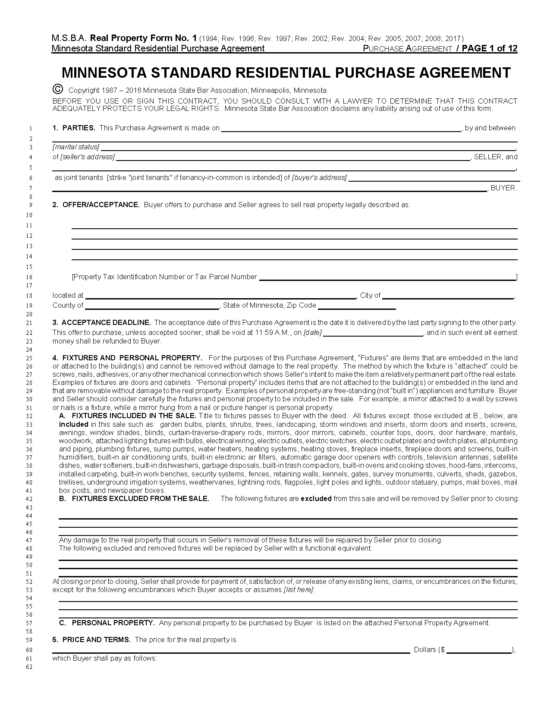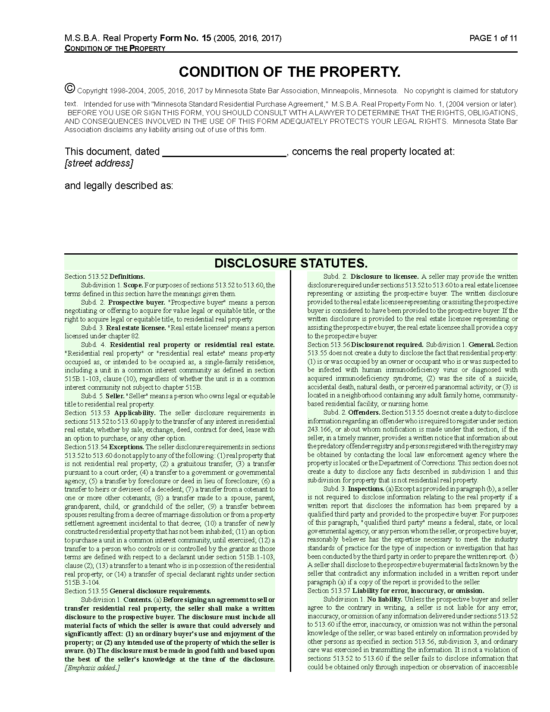

The Minnesota residential purchase and sale agreement is a legally binding document wherein a seller of real estate transfers ownership of their property to a buyer. The document will feature the offer amount, the buyer’s financing options, home inspection dates, and other contingencies for the parties to negotiate prior to finalizing the agreement.
State law requires sellers to furnish a statement disclosing the home’s condition, stating all defects that might risk the buyer’s safety or alter their decision to purchase the property. Alternatively, the seller may provide the buyer with a professional home inspection, or if mutually agreed to by the seller and buyer, the disclosure may be waived altogether. Upon completing the purchase and sale agreement and inspection report, unless waived, both parties may sign the agreement and transfer ownership of the home.

Minnesota State Bar Standard Residential Purchase Agreement – Only to be used by official members of the Minnesota State Bar Association to perform residential real estate transfers.

Condition of Property (§ 513.55) – A required form disclosing the condition of a residential property and any defect or damages that might affect the health and safety of the tenant, or the value of the property.

Lead-Based Paint – This state-mandated disclosure for real estate transfers involving residences built before 1978 is used to disclose the risks associated with hazardous lead-based paint previously used regularly in homes prior to federal bans.

Methamphetamines (§ 152.0275 Subd. 2 (m)) – Prior to the completion of a real estate transfer, the owner of the property must disclose in writing to the buyer if, to their knowledge, any production of methamphetamines has occurred on the premises, and if so, whether an order from the health department or county sheriff prohibiting the use of the contaminated property (until the contamination has been remediated according to the guidelines in § 152.0275 Subd. 2 (e)) has been issued.

Radon (§ 144.498 Subd. 3) – Individuals transferring ownership rights of a residence must disclose whether the property contains concentrations of radon and whether any tests assessing the concentration levels of radon on the premises have been performed. Documentation containing the most up-to-date records of radon concentration in the premises, descriptions of any radon concentration, a radon warning statement containing the language specified in § 144.498 Subd. 4, as well as the “Radon in Real Estate Transactions” guide provided by the Minnesota Department of Health must all be furnished to the transferee.

Sewage Treatment System (§ 115.55 Subd. 6) – During the transfer of real estate, the transferor must supply a written document disclosing how sewage produced at the property is handled and whether the sewage is sent to a facility permitted by the agency. If the sewage does not go to a permitted facility, additional descriptions of the property, the sewage system, and the location of the system should also be provided.

Wells (§ 103I.235) – During the final stages of transferring the ownership rights of the property to the buyer, the seller is required to disclose via a written statement the status and location of all known wells on the property, as well as a map detailing the locations of each well, if any.

Wetlands, Shorelands, and Flood Plain (§ 103F.111 Subd. 4, § 103F.205 Subd. 4, § 103G.005 Subd. 19 (a)) – This disclosure form is used only by individuals transferring property located in an area containing wetlands, shorelands, or flood plains.